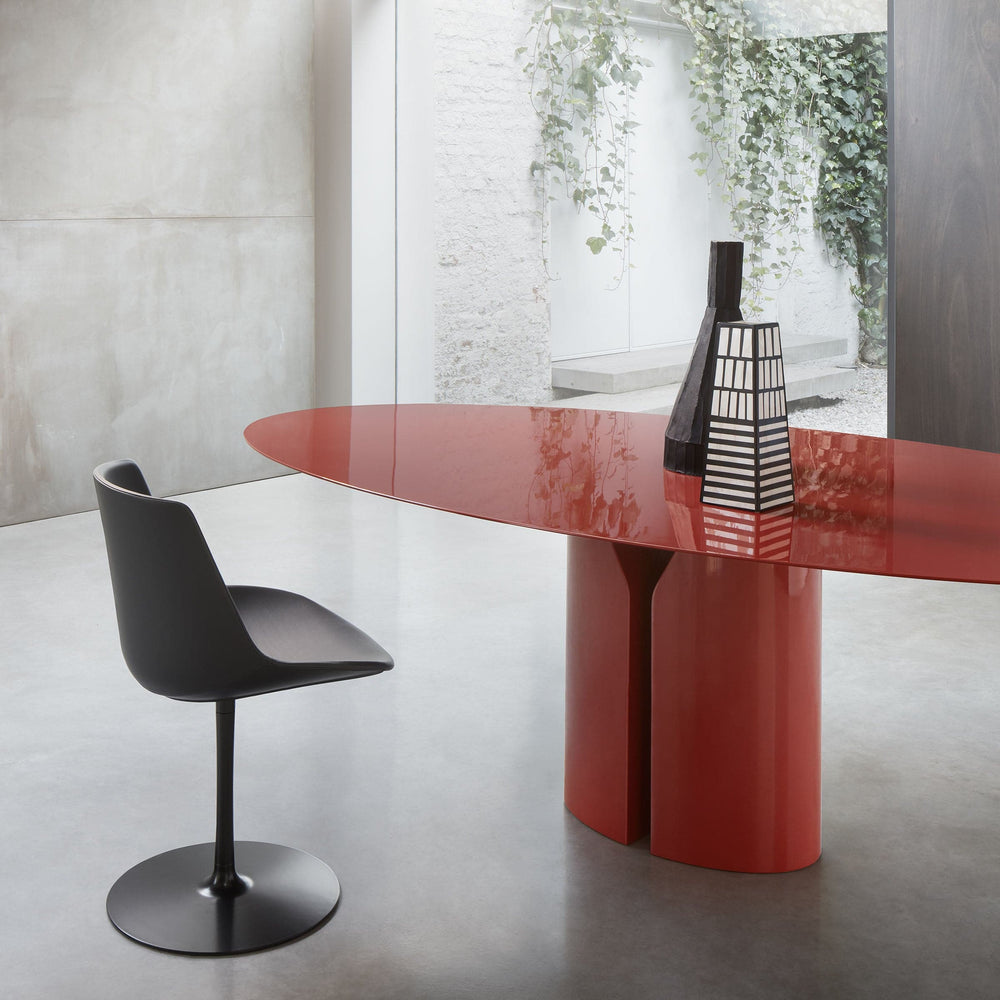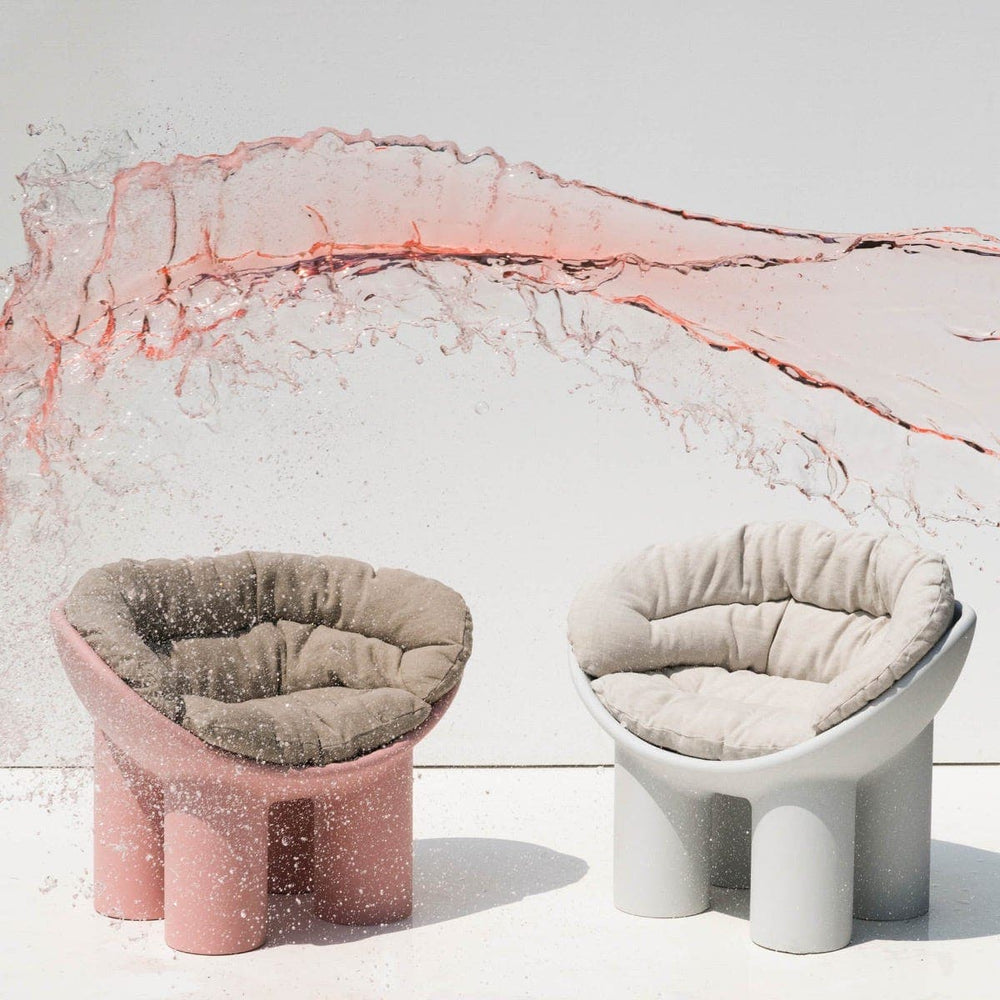EASTER EGGS: IN ART, DESIGN, AND HISTORY
The List #09

This month’s The List is an exploration of objects that are inspired after the essential forms of the egg and its fragility but also its perfection and resilience.
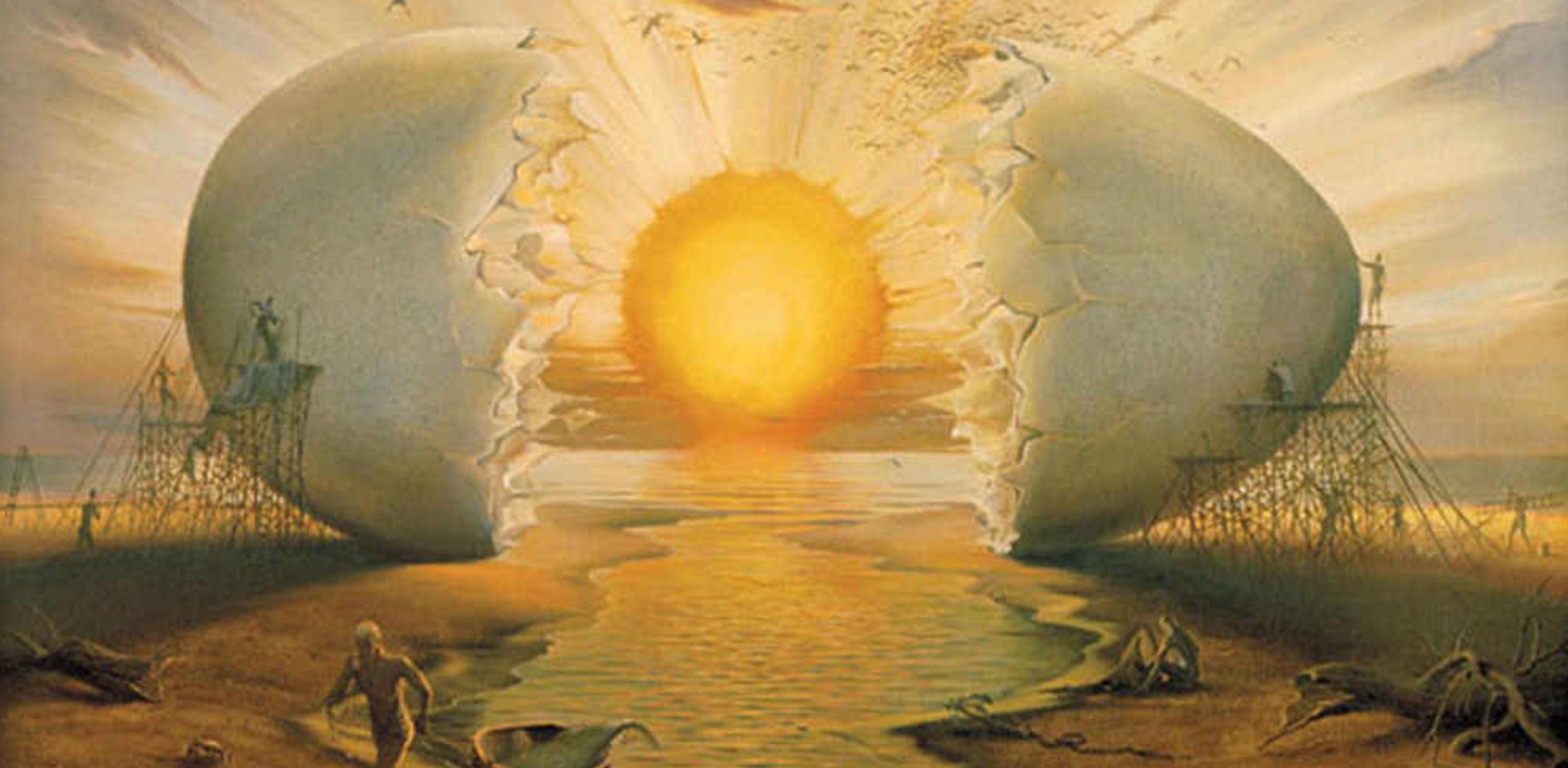
Salvador Dalì, Aurora, 1948
Easter is just around the corner, and with it comes the egg in all its glory. At Easter, eggs are symbolic religiously, are found on tables as decorations, are made from chocolate, and are filled with candy so children can search for them in Easter egg hunts.
Easter festivities are often typically oriented towards the littlest members of the family, yet since 2020, many of us have changed our approach. With the pandemic first and now the war in Ukraine, our center of gravity and our priorities have shifted.
Easter 2022 will be different from other years. And I believe that the egg, as a symbolic icon, represents an anchor. For the first time, I feel myself drawn to discovering its hidden meanings and to seek out representations of eggs and their meaning in art from the Middle Ages to today.
Eggs remind us of what we desire at the moment: we desire birth and rebirth, recognising the egg as a symbol of fertility, growth and evolution.
UKRAINIAN “PYSANKY”
Pysanka Museum; Kolomyia, Ukraine; some of the 10,000 eggs on display at the museum
Any pretext, however small – like this month’s edition of The List – is essential to defending the memory of Ukraine, which now more than ever is fighting to preserve its independence and identity.
Ukraine boasts an exceptional tradition which is a point of convergence between Eastern and Western culture, starting from the ideals of the Byzantine empire to our own Renaissance.
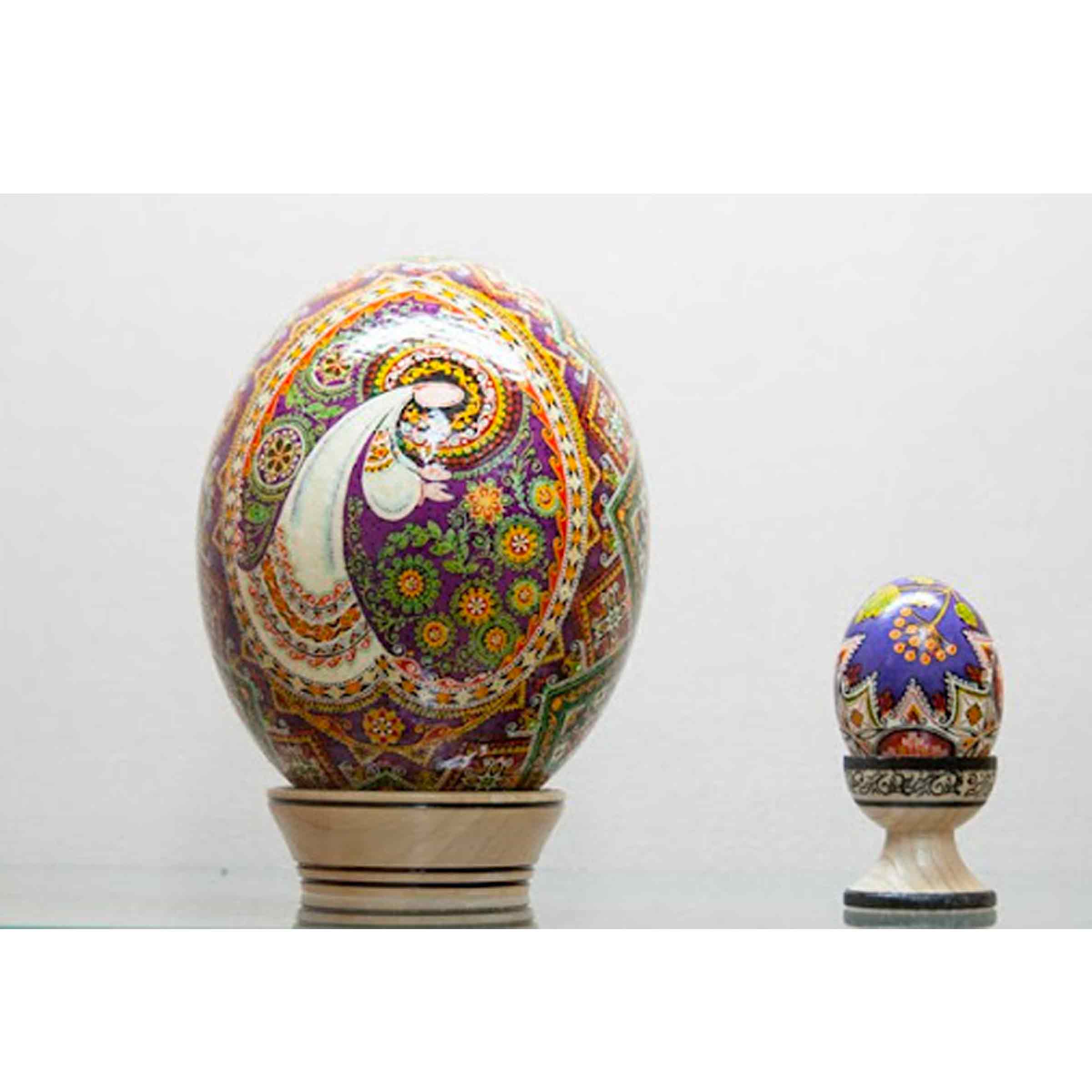
Few know that the tradition of the Easter egg, called pysanka, originated in Ukraine over 2,000 years ago. The eggs were initially decorated with an ancient wax technique which was used to outline the shape of the design on the egg. Once it was dry, it was then removed to reveal the underlying outline which had not been dyed with pigment. This is the same technique used for batik dyes (where areas that are not to be dyed are covered).
Eggs are not only a symbol of Christian rebirth, but also preserve the earth from the harsh temperatures of winter. It also protects against famine, and is a protector of human and animal life. It is thus a good omen to offer eggs as gifts or to use them as decorations around the house and garden.

The city of Kolomyia, Ukraine is home to the world’s only museum dedicated to Easter eggs. Founded in 1987, the museum now boasts a collection of over 10,000 decorated eggs that come from the local area but also from neighboring countries, like Poland, Romania, Belarus, and Czech Republic, and from far away India, Canada, USA, Pakistan and France.
L’INFINITO
Lucio Fontana; The End of God; Italy, 1963-1964
This piece by Lucio Fontana is part of a “Spatial Concepts” series created on oval-shaped canvases that were all the same size and were reminiscent of eggs with irregular and cracked holes, gashes and graffiti. The “The End of God” collection was defined as follows by Fontana himself in an interview in 1963: “For me, they mean the infinite, the inconceivable thing, the end of figuration, the beginning of nothingness”.

In an interview in magazine Left, critic Bruno Corà explains the deep meaning of this powerful and mysterious work of art: “The egg is symbolic and has always been represented in paintings, philosophy and science. This piece has such an emblematic value that it provokes many reflections…In iconography, it is the emblem of perfection, of the origin of life, it refers to the supernatural, but it is also a cosmic symbol... Fontana created this form of this and then inflicted on it his dramatic blows with an awl, declaring the end of that integrity which for so many centuries had represented the structural element of this image...In this sense, too, his was a momentous gesture...That breaking through of the canvas marked the opening of an unprecedented space. The surface of the canvas as an emblem, as a base for artwork together with the wall, had always been a central aspect for painters. In this way, Fontana ended a very great temporal parable and launched a new era”.
THE MAGIC EGG
Egg Castle; Naples, Italy, I-XVI century A.C.

Located on the islet Megaride, between the districts of San Ferdinando and Chiaia, is the oldest castle in Naples, Castel Dell’Ovo, or Egg Castle.
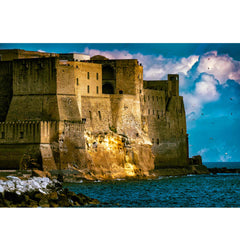
According to legend, the castle owes its name to the magic egg that Latin poet Virgil was said to have hidden inside a cage in the basement of the castle. The egg was heavily guarded, because it was considered to have the power to keep the entire fortress standing. From then on, the fate of the city of Naples has been tied to that fabled egg.
THE FIRST FABERGÉ EGG
Peter Carl Fabergé, The Hen Egg; Saint Petersburg; 1885; gold and rubies
This opaque white enamel egg resembles a real egg shell, twisting open like a matryoshka doll to reveal a yellow gold “yolk” inside. Then further inside is another surprise: a golden hen with ruby eyes, which in turn holds a miniature imperial crown containing a small ruby egg.
This egg measures 64mm high with a diameter of 35mm, and was the gift that Alexander III – the second-to-the-last Russian Tsar – commissioned from in 1885 Peter Carl Fabergé for Alexander’s wife, Tsarina Maria Feodorovna. The original gift was so well received thanks to its originality and fine workmanship that the lucky goldsmith was proclaimed court jeweler and commissioned to create a unique surprise egg each Easter.

Fabergé crafted 59 jeweled eggs between 1885 and 1917: fifty-two of them for the imperial family and the rest for private clients, but only forty-six remain in museums and private collections around the world while the others have gone missing. Fabergé eggs, which open across the middle or lengthwise, were all different from each other in size and appearance and were made from a wide variety of materials including enamels, semi-precious stones and metal. It would take several craftsmen an entire year to create one. These prized miniature eggs are highly sought after today by collectors worldwide, and between 1989 and 2009 other eggs were produced under a Fabergé license by German goldsmith Victor Mayer GmbH & Co. KG.
DALÌ’S EGG OBSESSION
1. Philippe Halsman; Dali in an Egg; 1942; photograph
2. Salvador Dalì; Dalí Theatre and Museum; Figueres, Spain; 1960-1974

In 1960, surrealist painter Salvador Dalí chose his home town of Figueres as the setting for most of his works, even donating a museum that was built on the site of the Municipal Theatre of Figueres which had been destroyed in a fire in 1939. Described as the largest surrealist object in the world, it is the artist’s testament and contains most of his works.

It is a theatrical work and a grand stage where Dali exhibited his installations and obsessions, which included eggs. He was fixated with them, and they were his preferred symbol for the physical coexistence of a hard outer part and a soft inner part. But the egg also represents birth, care, survival and rebirth. “Make me an egg”, he would ask his wife, Gala, eating a soft-boiled egg and toast on those days he needed to create.

The theater-museum has large egg-shaped decorations perched on the roof, protecting not only the building but also the city, in a hope of an ever-evolving future. Knowing his painting style, perhaps we could even call Dalì the egg genius.

THE RENAISSANCE EGG
1. Piero della Francesca; Montefeltro Altarpiece; 1472; Pinacoteca di Brera in Milan
2. Achille Castiglioni; Brera floor lamp, wall lamp, pendant lamp; Flos; Italy, 1992
The egg is a symbol of divine perfection and gained prominence throughout art history, from Renaissance paintings to contemporary art and design.

In 1472, Italian painter Piero della Francesca depicted an ostrich egg suspended above the head of the Virgin Mary, creating the painting known as the Pala di Brera or Montefeltro Altarpiece, which is housed at the Pinacoteca di Brera in Milan. It is an extraordinary piece thanks to its perspective, proportions and iconography. The central perspective converges from the vanishing point that starts from the eyes of the Virgin Mary. Her oval face is perfectly centered under the ostrich egg, which hangs from the center of the vaulted ceiling, creating a harmonious circular composition of elements. The egg here is symbolic of life and creation, floating above Mary’s head, symbolizing her immaculate conception, life-giving force, and divine perfection. The egg was also an emblem of the house of Federico da Montefeltro, who commissioned the work from Piero della Francesca.

Over 500 years later, designer Achille Castiglioni was inspired by this extraordinary painting and designed a ceiling lamp that is a modern-day oval, milk-coloured opaline glass version of Piero della Francesca’s egg.
ORIGINS OF THE WORLD
1. Constantin Brâncuși; Sculpture for the Blind (Beginning of the World); 1916
2. Constantin Brâncuși; The Newborn; 1915

A significant part of Romanian sculptor Constantin Brâncuși’s work features abstraction and simplicity. But for him, “simplicity” was not a goal in and of itself, nor is abstraction. In his work, he attempted to get to the core. “In art, one does not aim for simplicity. One achieves it unintentionally as one gets closer to the real meaning of things”, he said.

His Sculpture for the Blind is perfect, smooth, attractive to the eye and to the touch, and represents life that is awaiting to be born. This egg-shaped sculpture symbolizes beauty, and its reduced and compact forms speak of the beginning of the world and of the origins and mystery of human life.
His sculptures have perfect, expressive forms in their abstract and conceptual minimalism, placing the artist at the forefront of modern sculpture.
ART OFFERED TO THE PUBLIC
Piero Manzoni; egg; Consumption of dynamic art by the art-devouring public; Milan, Italy; 1960
On 21 July 1960 at the Galleria Azimut in Milan, Piero Manzoni staged a performance with his students from the Brera Academy. His thumbprint was placed on 150 hard-boiled eggs, which were devoured by the public in just a few minutes. Eggs, in their sacredness, perfection and being symbolic of regeneration, were turned into art thanks to the artist’s fingerprint, and those works of art were then ingested.

The idea was that of the consumption of art, of interiorisation, and of art as food for the mind and body. Manzoni put body and soul into his work to create a sort of physical and unbreakable bond between the artist and public. This was a provocation of course, but if one thinks of Duchamp, or Caravaggio or Courbet, art has always been provocative. And food has always been a powerful means of expression.
Egg no. 34, which was fortunately not eaten during the performance, can be found on display at twentieth-century art museum Museo del Novecento in Milan.
BROKEN EGG
Jeff Koons; Cracked Egg (Magenta); Celebration series; 1994-2006 stainless steel with transparent color coating (1 of 5 colors)
This piece is artist Jeff Koons’ most important sculpture, standing over five feet tall with its polished, magenta-colored, vibrant shell, reflecting our enchanted gazes and its surroundings. It is an incredible technical feat achieved over a period of twelve years and is a key work in Koons’ historic Celebration series, alongside other masterpieces like Balloon Dog and Tulips.

The central focus of the Celebration series is objects and childhood memories along with the cycle of life. The project revolves around objects that recur cyclically in our lives over the calendar year: flowers in spring, balloons on birthdays, hearts on Valentine’s Day, and eggs on Easter. This piece plays on the fragility of the egg and explores the theme of the ephemeral and the eternal.
Koons explained in an interview in ArtsLife: “The fragments of shell emphasize the fusion of opposites, appearing simultaneously organic and synthetic, fragile and resilient…I was interested in the dialogue with nature and aspects of the eternal, the here and now, the physical with the ephemeral…the symmetrical and asymmetrical, a sense of the fertile”.
Koons is the highest-rated artist on the market, and this piece sold at Christie’s in 2014 for over £14m.
LES LALANNE
Claude and François-Xavier Lalanne; Cocodoll bed; France; 1964

This French couple was famous for designing surreal furniture inspired by the animal kingdom. They shared their lives and careers for five decades, leaving behind an incredible collection of works that were designed to be inhabited and to become everyday objects. Their works reference 20th century Surrealism, classical antiquity, French craftsmanship, and the Baroque period.

The last image is a photo taken in a living room of a Parisian flat designed by Jacques Grange.
THE NEST
Gianni Ruffi; Cova sofa; Gufram; Italy; 1973; limited edition

Could there be anything more comfortable and cozy than a human-sized nest? Cova is a sofa that is both a piece of furniture to be used and enjoyed as well as a work of art.
Since the 1960s, Florentine designer Gianni Ruffi has designed highly conceptual pieces using rural materials from his hometown. His experience with art and design brought him into close contact with the ironic culture of the works of American Pop Art, where everyday objects were blown up in size and radically reinterpreted in their function.

Ruffi quickly gained recognition around the world thanks to several exhibitions, and Cova skilfully captures the atmosphere of the time, combining expressive design with a dramatic sense of the surreal.
THE EGG CHAIR
Arne Jacobsen; Egg Chair; Fritz Hansen; Denmark; 1957
This chair – called the Egg Chair because it resembles a smooth, broken eggshell – is a modern version of the classic bergère chair with its curved headrest. It is a cocoon you can sink into and a relaxing refuge, designed for the rooms and lounge of the SAS Royal Hotel in Copenhagen.

The Egg Chair was produced using the “klein” molding technique, a pioneer in the development of plastic shell furniture, but Jacobsen improved on its expressive potential and fully harnessed the sculptural capabilities made available by this technique. He fused together all the distinct parts of a chair into a single shell, especially the seat, backrest, headrest and armrests. The entire piece was upholstered in leather or fabric with an intense meticulous work that stretches the upholstery, giving the armchair its futuristic forms.
POST-FUTURISTIC DESIGN
Henrik Thor-Larsen, Ovalia Egg Chair, Torlan Staffanstorp, Svezia 1968

The Ovalia Egg Chair was presented for the first time at the Scandinavian Furniture Fair in Stockholm in 1968. It was instantly a huge hit with the public, which was seeking unconventional, informal and symbolic seating, so much so that it became the star of many films of the time. Among these was the 1997 Men in Black trilogy starring Tommy Lee Jones and Will Smith and directed by Sonnenfeld Barry. The Ovalia Egg Chair’s eccentric shapes fit in perfectly with these films about the encounter between human and alien worlds.

The chair’s shell, made of fiberglass and covered with fabric and polyurethane foam, rests on a rotating polished aluminum disc.
SOFT EGG CHAIR
Philippe Starck; Soft Egg; Driade

Soft Egg is a stackable polypropylene seat with a soft and cozy appearance. With its side slots, it can drain rainwater, making it perfect for outdoor use as well as indoors.
This monobloc chair is one of the many that have been part of the history of design since the Eames Shell in the 1950s, which was made from new materials like fiberglass-reinforced plastic. This was a material that could be molded into organic shapes and produced more cheaply, and had never been used on consumer products before.
WHICH CAME FIRST?
Arago Design; La Gallina Retorica; Italy; 2021

Which came first: the chicken or the egg? La Gallina Retorica or “Rhetorical Hen” is a piece by Arago Design that transforms this famous rhetorical question into a fun, useful object. It is a ceramic treasure chest that hides away the secrets of life, or any other surprise that one wants to keep and then reveal to the world.
Elisabetta Di Bucchianico and Dario Oggiano, the creative driving force behind Arago Design, explained in an interview:
“The study of cosmogonies, the investigation into the origin of life, devoting oneself to the most complex and profound questions of existence, are considered the exclusive prerogative of the most sophisticated intellectual circles, but this is not the case. They can, for example, become a creative experience, as happened with the creation of this special object. The most complex questions arise unexpectedly from the observation of phenomena closer to everyday life, or from an apparently simple object, as we want to demonstrate with our Rhetorical Hen, to which we wanted to give a form and a soul that could challenge the adventurous search for meaning and encourage thinking”.
EGGS WITHOUT CHICKENS
Annie Larsen; Egg Without a Chicken; UK; 2019

Around 36 million eggs are consumed every day in the UK. Eggs contain complete proteins and can provide essential or non-essential amino acids as well as vitamins, minerals, antioxidants, cephalin, lecithin, cholesterol and saturated, monounsaturated and polyunsaturated fatty acids. Nutritionally, eggs are good for everyone and at every stage of the human life cycle. This is why eggs are being increasingly consumed, as they are indisputably the most perfect edible element that exists in nature.

Designer Annie Larkins created her project in response to the industrial farming practices used to keep up with the world’s high demand for eggs. Would it be possible to recreate an egg, in the laboratory, that not only delivers nutritionally and in terms of taste, but also outperforms the biological capabilities of the chicken?
The designer created “eggs” with alternative shapes in the lab. Their main features were maintained, like texture, white egg white, yellow yoke, and a shell that breaks just like in nature, but without disturbing any chickens in the process.
ILLUMINATED EGG
Ben Swildens; Egg Lamp; Fontana Arte; Italy; 1972
Eggshells are the epitome of lightness, and Ben Swildens’ Egg Lamp imitates this feature with its white opaline glass that diffuses light evenly. An absolute classic.
CONTEMPORARY MURANO GLASS
Roberto Beltrami; Vanità; blown opaline Murano glass egg-shaped sculpture; Wave Murano Glass
This sculpture was created by Wave Murano Glass in a furnace that dates back to 1850 and is located in the heart of the island of Murano in the Venetian Lagoon.
It is here that young master glassmaker Roberto Beltrami creates stunning blown glass designs by combining centuries-old techniques with modern manufacturing processes and finishes.
DOPPIA VITA
Gae Aulenti; Giova table lamp; Fontana Arte; Italy; 1964
Is it a vase or a lamp? The Giova table lamp has two overlapping spheres, the lower of which is a lamp with an internal sphere in glossy, white blown glass and that houses the light source, while the upper one looks like a vase. But the lamp also resembles a stylised hen hatching her egg. The upper half part can rotate on itself or be removed entirely.
This lamp is a timeless piece of industrial design and part of international design history. It was created by Gae Aulenti, who joined Fontana Arte as creative director in 1979 and left behind a legacy of iconic lamps and furnishings.
SITTING ON AN EGG WITHOUT BREAKING IT
Denis Santachiara; Tato pouf; Baleri Italia; 1995/2001
Tato is a seat or footstool that is as playful, poetic and intelligent as its eclectic creator.
This fun and elegant egg-shaped pouf is a perfect accessory for any space and will go with any style of furnishings.
SOFT-BOILED EGG
1. Georg Flegel; Still Life; Germany; 1630
2. Jaime Hayon; Eggi brass egg holder; Paola C.; Italy
3. Egg timer; Thometzki

Oeufs à la coque, or soft-boiled eggs in French, literally means “eggs on the shells” and originated with French Renaissance cuisine.
Soft-boiled eggs are often eaten at breakfast, and are generally brought to the table in an egg holder to facilitate eating them as they sit up straight. Louis XV of France, who was said to have had a passion for soft-boiled eggs and to have eaten them every Sunday, had a poultry farm created at the Château de Versailles.

RECIPE TO MAKE SOFT-BOILED EGGS
Ingredients:
Salt
Eggs
Use fresh, whole eggs. Place a saucepan filled with water on the stove and bring it to a gentle boil. When it begins to boil, add the eggs and cook for 4 minutes, using an egg timer if desired. The temperature and size of the egg can affect the cooking time. Calculate 4 minutes from when the water boils for medium-sized, cold eggs; or 3 minutes at most for room-temperature eggs.
Drain the egg and run them under cold tap water for a few minutes. Dry the eggs and remove the top of the shell with a knife. Add salt and pepper if desired and serve with bread or toast.
Soft-boiled eggs should be eaten immediately.
Tip: If you put the egg in the egg holder tip-down, it will be easier to open because an air pocket will have formed.











